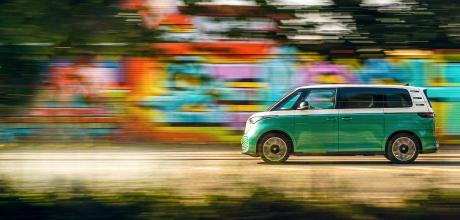300-Mile test: Volkswagen’s ID. Buzz explores Denmark and Sweden
Forget the disappointing ID.3 and 4 – this is a chance for VW to bring some magic to the world of EVs, by tapping into its funky history.
The 300-mile Test
NEW CAR MEETS REAL WORLD
VW’s real electric journey starts here.
For free spirits everywhere, VW’s electric ID. Buzz
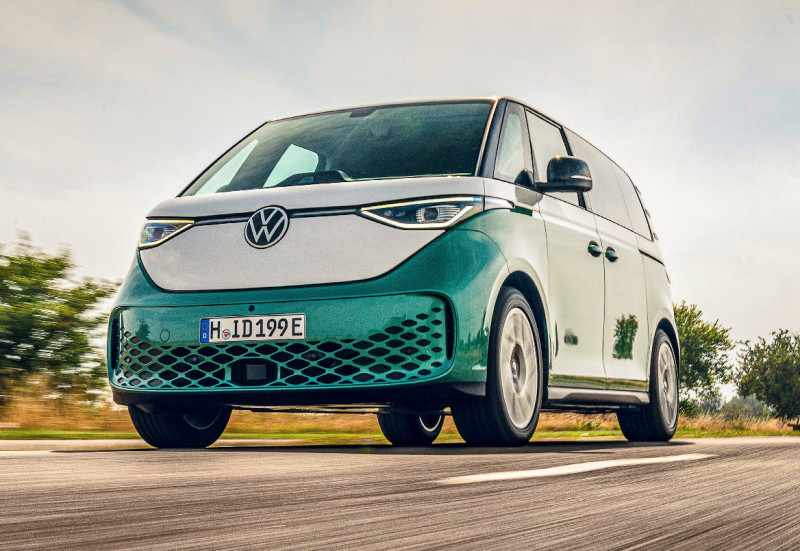
Jamie from New Jersey wants to buy this thing so bad he’s offering five grand in cash for an early 2023 delivery. Here are my contact details, bro, and no, EU-spec is not an issue. Do I look like a car dealer?
Harald and Britta from I-forget- where bring a notepad and a folding rule to check out the exact boot size, different seating configurations and their effect on rear legroom. Anna the receptionist from the Nyhaven Hotel begs our photographer to take a couple of flattering smartphone pics of her posing in front of the white-over-sage ID. Buzz in the morning sun.
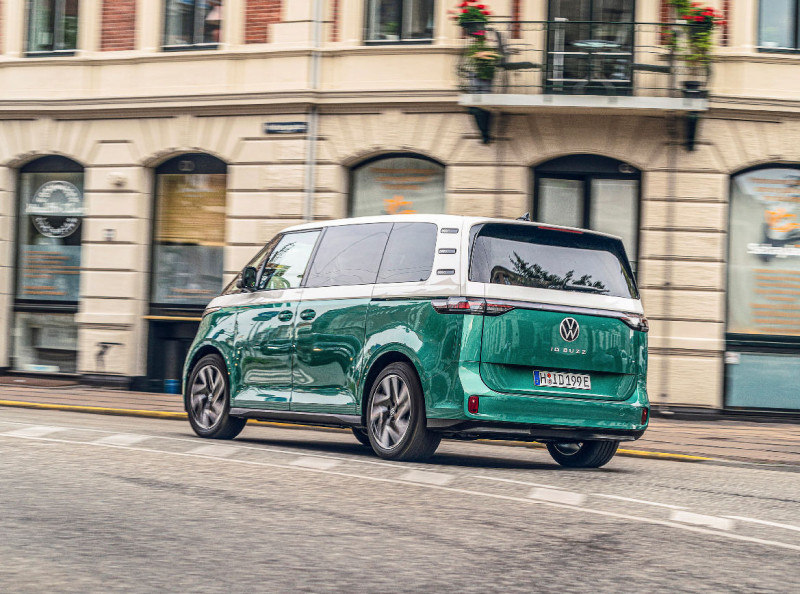
Every second person who starts a conversation with us asks the same three questions. Is it any good? What’s the starting price? When can I get one? The responses make their smiles even wider. Yes, the new Volkswagen is a decent piece of kit. If you order now, European dealers are quoting a mid-2023 delivery, but come next month the waiting list may already be stretching into 2024. Prices start at £57,115.
The ID. Buzz prototype I drove in the April issue was a disappointment. The partly camouflaged car just wasn’t there yet in terms of perceived quality, chassis fine tuning, vehicle dynamics and software integration. Six months later, we’re chuffed to discover a much more complete vehicle. Our test car is still burdened by a bunch of digital flaws, but the driving experience puts a smile on our faces from the word go.
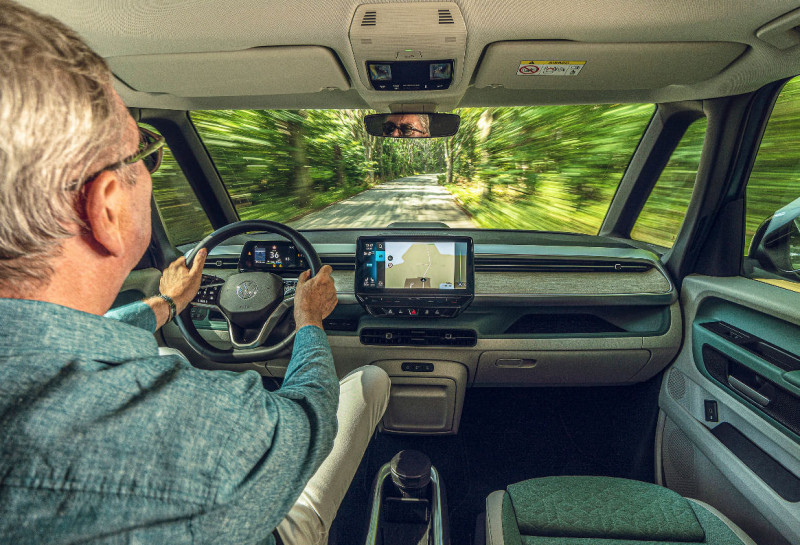
We’re in Copenhagen, a busy city which strictly enforces a 30km/h (18.6mph) speed limit. Cars, buses and taxis as well as cyclists use bespoke lanes. The limit on many bigger roads – arrow-straight and as flat as a salt lake – is 50mph. Trying to find a photogenic corner within a 15-mile radius of the Danish capital is futile.
But that’s okay since the ID. Buzz is not about chasing g-force around bends or frantic motorway speeds. Like its great ancestor, the original Beetle-based T1 microbus, the latest fully electric metamorphosis still has its motor strapped between the driven hind legs. At 201bhp it is over eight times more potent than the original effort, which maxxed out at 53mph, but at a portly 2510kg it exceeds the T1’s kerbweight by a factor of 2.5.
In line with the other ID models, its rear motor-transmission layout will under no circumstances be persuaded to succumb to power oversteer – there is not even an ESP Off button. The safe, stoic handling balance is cemented by the impeccable weight distribution and the road-hugging centre of gravity ensured by the battery pack being embedded between the axles. Some would describe the performance as adequate, others may consider it lacking. At any rate, it can accelerate to 62mph in 10.2sec. The price you pay for the considerable weight and the drag coefficient of 0.28 is a 90mph top speed.
Our route includes a brief excursion to Sweden via a long tunnel and an even longer bridge. Sadly, fog and haze obliterate the view of one of northern Europe’s most noteworthy bird sanctuaries.
Our main impression of Sweden is that Malmö must be the new world headquarters for super-tall speed bumps, which appear with unreal frequency and proudly wear a million battle scars, but the ID. Buzz is untroubled by these obstacles.
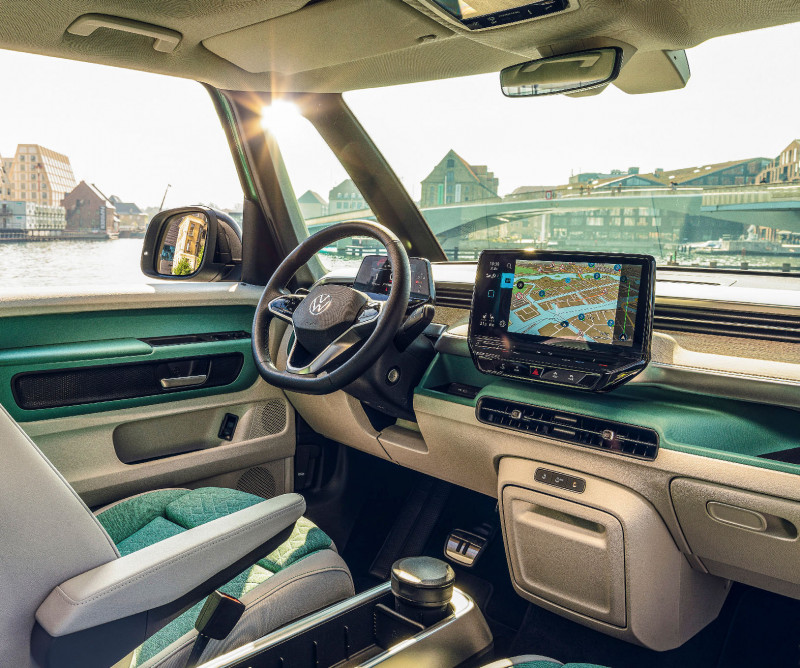
Despite our car’s large-diameter wheels with low-profile rubber, the long wheelbase, substantial weight and spot-on spring and damper calibration yield a perfectly compliant five-star ride. The unladen MacPherson-strut front suspension and multi-link rear soak up vagaries as if supported by a pair of invisible air springs.
It’s this cosseting and pampering ride which coins the first driving impression together with the muted cotton-wool silence which introduces a new quality to long-distance road travel. Thankfully, artificial sound tuning is not on the agenda here.
On a German autobahn, the distance-to-empty read-out all too often dominates your planning and your pace. Will you make it, or will you have to squeeze in an extra splash-and-dash pitstop? In Denmark, where traffic moves at a slower pace, range seems to be a much less pressing issue. We set off with an indicated 95 per cent charge promising 255 non-stop miles. But since I can’t resist flooring the throttle now and then, the on-board computer displays at the end of the day a slightly less eco-friendly 2.28 miles per kWh.
Well before the charge warning light comes on, we bag the last unoccupied high-voltage feeding point in Malmö’s biggest 350kW Ionity Power Park. Although the max charge power of the Buzz is limited to 170kW, it takes only 10 minutes to boost the range by a little over 100 miles. Most EVs take your heart by storm thanks to the instant torque delivery and the punch that follows. The ID.
Buzz is somewhat different since it musters only a modest 229lb ft, which is not quite enough to show off when the lights turn green, and not nearly enough to reel in busy B-roads with a vengeance. Although the single-speed transmission does its best to turn grunt into traction, the massive weight has other ideas. But not to worry: simply reset the expectation meter inside your head, let cruise control cool off excess ambition, and allow maintaining the flow to become the new favourite way of driving. The continuity of motion, the totally relaxed waftability, the barely audible effortlessness and the cushy caressing chassis add up to a driving experience that makes outright performance an almost irrelevant commodity.
Denmark is a good place to adopt this chilled-out thinking. It may be a great destination for sailors, windsurfers, cyclists, fly fishing aficionados, mushroom and berry pickers, bird watchers and other factions of the hygge outdoors community. But it’s bound to disappoint keen drivers. Why? Because the road network is devoid of dynamic highlights and challenges, and because elevation changes and longer sections of winding roads are few and far between.
Although the most outstanding qualities of the Buzz – the smooth ride and the quiet cabin, virtually devoid of wind and road noise – are most obvious on the open road, it’s also worth noting the in-town usability. Its commendably tight turning circle of 11.9 metres is not at all bad for a 4712mm minivan sporting a long 2989mm wheelbase. Thanks to the reasonably quick and nicely progressive steering, the big, bold battery-driven box is surprisingly manoeuvrable around town and pleasantly involving beyond the city limit. The ventilated XXL front disc brakes are complemented by rear drums which don’t look great on the spec sheet but are perfectly sufficient on the road.
You may have read a lot of bad things about the VW ID infotainment system, and even one and a half years after the premature launch of the ID.3 the semiconductors are indeed still wingsuiting from bug to error. We’re not talking about the touchslider invasion and the touchpad confusion, which won’t be fixed before the facelift in late 2024. But why do spoken and haptic inputs still take so long to produce a result? Why does the traffic-sign recognition over-ride the cruise control by inadvertently accelerating as soon as the speed limit lifts?
And why does Wolfsburg’s wayward daughter of Siri and Alexa never shut up, but instead keep on asking ‘What can I do for you?’ out of the blue? Sadly, ‘Awmigawd, not again!’ is the wrong response; these words produce a list of Danish villages starting with an A like Aalborg, a restaurant named Ammans Deli and the music of Anne-Grete, who was popular in the ’80s.
No big deal? True. But how about the five stabs it takes to deactivate the vibrating lane-assist watchdog, which bares its fangs afresh every time you hit the starter button? These driving aids to me feel artificial and fragmented, and can easily become more of a worry than a help But certain digital wizardries are of course real assets. Take for instance Park Assist Plus, which can retrace the last 50 metres covered at low speed.
Since there are no paddles to adjust the level of regenerative braking, recuperation is instead governed by your choice of drive mode. In Drive, lift-off decelerates the Buzz at a casual pre-set rate. One more twist locks the black box in Brake, where up to 100kW of energy can be regained and the drive experience becomes one-pedal. What’s not currently available is on-demand coasting, letting you take advantage of sometimes considerable momentum. Even out in the sticks, there is almost always a charging station to be found, although most of them are still of the slow 11 or 22kW variety. This infrastructure originated in the Scandinavian habit of electrically pre-heating combustion engines for a cozy morning start after a freezing winter night.
EV density in the greater Copenhagen area is apparently second only to Oslo. Although there are numerous charge points, they tend to have long queuesof taxis waiting to use them. The situation is bound to get worse in winter when the miscellaneous in-cab warmth dispensers will take their toll.
Unlike in German cities, where EV street parking is free and charging is often subsidised, you must pay full whack in Denmark unless you have a special deal with a provider. Paying for a brief energy hook-up with my own plastic card turned out to be almost twice as expensive as using VW’s own (but temporarily unavailable) We Charge service, which operates in collaboration with seven major electricity suppliers.
The improved 3.2-generation sat-nav includes an e-route planner which suggests appropriate charging stops but does not yet display real-time pricing and available spaces. Expect various refinements and options to become available as the ID. Buzz saga continues. Rear-wheel drive, the 201bhp motor and the small 77kWh (net) battery mark only the first chapter. Next year, VW is going to release the long-wheelbase seven-seater which will again be available as Buzz and Buzz Cargo. A full-length glass sunroof is among the most noteworthy new extras. In late 2023, we expect to see the first of several 4Motion AWD versions. The most powerful iteration is rated at 340bhp, sources say. While its top speed will increase to 100mph, the acceleration time should shrink to 5.9sec. According to those in the know, there is a 400bhp GTX complete with 92kWh energy pack and a beefed-up rear axle in the works for model year 2025. There may also be versions with plush upholstery, with traditional skylights, with off-road paraphernalia, and even a twin-cab shortbed pick-up.
But in the here and now, today’s ID. Buzz is hugely impressive. After nine hours on the road, driver and passenger are still feeling remarkably fit and fresh. One major contributing wellbeing factor is the perfectly shaped and very comfortable massage seats. Another big bonus point is the abundant cabin space. There is no doubt about it: the ID Buzz is a unique offering which fuses clever packaging, spot-on looks, up-to-date electric propulsion and a truckload of emotional brownie points at a relatively affordable tariff.
Stopping briefly outside the famed hippy community of Christiania, we feel like rock stars stepping down into a sea of fans, waving. Founded in 1971, this commune in the heart of Copenhagen still embraces the Californian ‘make love, not war’ spirit. Collectivism and anarchism are part of the constitution, meditation gurus and yoga grandmasters hold court side by side, jesters and musicians uncoil their routines on makeshift micro stages.
Cars are illegal in Christiania, even electric ones, but this side of the graffiti-freckled stone walls the ID. Buzz is in no time at all swarmed by flower-power disciples, and the billowing flock of tourists. Sure enough, there they are, the same questions all over again: is it any good, when can I get one, how much? If this unbridled spontaneous enthusiasm is anything to go by, the 130,000 units VW intends to build annually from 2023 onward will fall some way short of meeting the demand.
After nine hours on the road, driver and passenger are still feeling remarkably fit and fresh
TECHNICAL DATAVW’s ID. Buzz
- PRICE From £57,115 (£62,995 as tested – 1st Edition)
- POWERTRAI N 77kWh battery, rear e-motor, rear-wheel drive
- PERFORMANCE 201bhp, 229lb ft, 10.2sec 0-62mph (est), 90mph
- ON SALE 2022 Now
- WE IGHT 2510kg
- EFFICIENCY 2.92 miles perkWh, 255-milerange, 0g/kmCO2
- PLUS Comfortable; adaptable; highly desirable
- MINUS Modest performance; ID infotainment
- ALTERNATIVES VW Multivan VW’s hybrid alternative: stylish, with a super-flexible interior, but pricey and dynamically ordinary Citroën e-Space Tourer Electric nine-seater based on the Dispatch van; range isn’t great, and drives like a van
Pick-up: 0 miles
- The transition from the 2017 concept to the 2022 production car is a rare case of turning a promising design exercise into a great-looking product.
- 0 miles Slightly shorter than the Passat estate, the Buzz has more cabin space than the defunct Phaeton and a bigger cargo area than the T6.1 Multivan.
- 14 miles Even when fitted with 21-inch wheels, the chassis of the ID. Buzz harbours more compliance than any other VW people mover from Caddy to Crafter.
- 33 milesOne speed only, but two directions and five positions to be selected by the twist or push stub behind the wheel. Engaging neutral is fiddly, though.
- 54 milesNo quibbles with the steering action, but the wheel itself is dotted with too many buttons and touchsliders which are neither precise nor big enough.
- 65 milesEven with charging cables occupying the lower tier, the boot space is big and easily accessed. Passenger seats fold away for extra cargo carrying ability.
- 76 milesThe term ‘IQ Light’ suggests intelligent beams, which isn’t far from the truth. No need to pay for the optional upgrade when standard is this good.
- 90 milesEco, Sport, Sport+ and Individual modes are offered. Individual is best because it lets you combine lively throttle with supple damping.
- 117 milesWhile the trim is as green as can be without compromising wear and tear, it’s the expert shape and cushioning that make this furniture special.
- 191 miles Since waiting in the car while it charges up is always frustrating, we plug in and then leave the car to it while we stock up with two shots of espresso.
- 281 miles The multimedia system follows its own peculiar logic, operates on three different menu levels and is more of a nuisance than a help
- Drop-off: 303 miles Despite its foibles, the Buzz is huge fun to drive on a long day, and very comfortable too. A risky project, but VW has pulled it off in some style.
WHAT ABOUT THE VAN?
Tom Webster, vans editor of the Parker’s website, has driven the Cargo version of the ID. Buzz: It’s fancy for a van… The van version is just as cool outside as the peoplecarrying Buzz. Inside you get some desirable flourishes, too, with the big central touchscreen, a heated seat and cruise control – features van drivers can normally only dream of on an entry-level model. But the colours are from the black and grey part of the chart and wannabe camper-van creators don’t get the option to spec it up to match the car.
It’s not that practical...
Outside, the Buzz is as big as a LWB Citroën Berlingo van, but it only has as much loading space as a SWB model and it can’t take as much weight either. Inside, the funky low roof means no overhead storage.
What about the price?
It starts at £38,125, plus VAT, or about £8k more than the Berlingo and only £6k less than the much more practical Ford E-Transit. But neither comes close to its looks…
Denmark’s great for sailors, cyclists, bird watchers and berry pickers but it will disappoint keen drivers
It’s tall, but only estate-car long, so works just fine in town Cartoon dog with a massive badge for a nose? It works. Buzz is rugged enough for active families; expect an SUV-style variant to follow.UK gets three spec levels, and a long list of options Quiet, comfy and quick enough, unlike the original. Expect a long-wheelbase version next year, with up to seven seats.
NOT A GREY DAY
Contrasting colours are not compulsory, but they bring out the best in the interior design. Leather is not an option for the upholstery.
SPACED OUT
Front is magnificently roomy, as are the rears even when slid forward by 150mm to expand the boot beyond its usual 1121 litres. Rear access is by sliding doors.
PIMM’S O’CLOCK
Storage box mounted between front seats can be removed. It’s an extra on the entry-level Life. There’s decent oddments stowage all round the Buzz cabin.
SPEAK OR PROD
Touchscreen is 12 inches on top-spec 1st Edition, 10 inches on the others. All versions come fitted with voice control.


